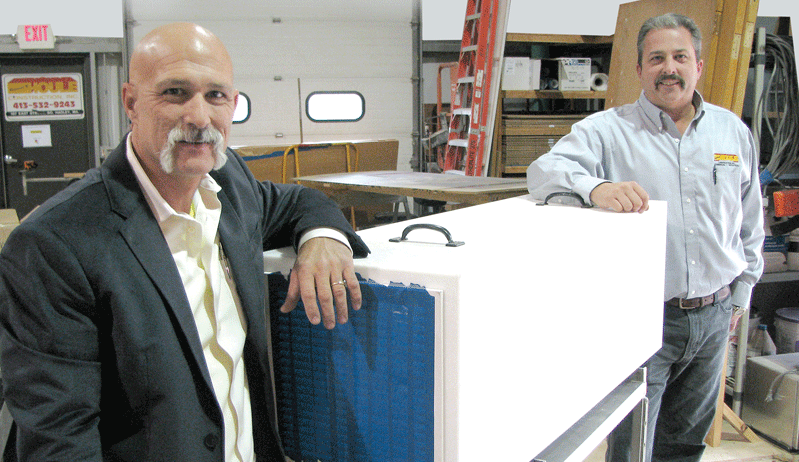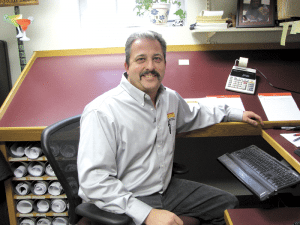Clinic in Construction
Houle Builds on Its Expertise in Healthcare Contracting
By KEVIN FLANDERS

Houle Construction President Tim Pelletier, left, and Vice President Bob Langevin, with a ‘baffle box’ used to keep air free of dangerous particulates.
But Ludlow-based Houle hasn’t been daunted by change, instead employing innovation and reinvention to succeed in a challenging business where plenty of other enterprises have failed.
Leading the way have been President Timothy Pelletier and Vice President Robert Langevin Jr., with more than 40 years combined at the company.
“We are healthcare-contractor-certified and have a tremendous amount of experience working in hospitals,” Pelletier said. “Our staff is up to date on all of the latest infection-control procedures.”
That’s critical in an age when construction at medical facilities has been far more closely scrutinized and regulated than in past decades. With the emergence, over the past 15 years, of new policies and protocols governing every project — from emergency departments to patient rooms — contractors must be certified before they can even consider working inside a hospital. Houle, boasting a staff of around 30 employees, is one of a few commercial builders in the area with experience in all aspects of healthcare construction.
Simply put, Pelletier said, his staff knows how to get the job done in situations where planning and execution are crucial. Hospitals are among the most challenging construction venues, partly because they can’t be shut down for weeks or months at a time to facilitate site work. As such, every member of the construction team must be adept at working seamlessly in an active medical environment, with minimal disruption to patients and staff.
For instance, “when you’re renovating an emergency department, you have to create a construction environment within the existing environment. The ER isn’t going to close so you can work,” he explained. And with hospital patients often resting in close proximity to where the work is being completed, he added, every procedure must be completed with an emphasis on safety and efficiency.
History in Healthcare
Operating in the beginning out of founder Raymond Houle’s garage in South Hadley, Houle Construction has evolved and grown to become one of the region’s noted contractors, particularly in the realm of medical facilities. The company’s clients have included Cooley Dickinson Hospital, Baystate Medical Center, Baystate Wing Hospital, Holyoke Medical Center, Mercy Medical Center, the Sisters of Providence Health System, and Genesis Health Ventures, among others.

Tim Pelletier says working on medical facilities means completing projects efficiently while keeping patients safe.
“We were told to figure it out and come up with a solution,” Pelletier said, recounting a situation about eight years ago when hospital infection-control departments began to implement new asbestos-abatement regulations in windowless areas of facilities.
In response to the changes, the staff invented what is now known in the industry as a ‘baffle box’ — a device used to diffuse torrents of air generated by negative air machines during asbestos-removal projects. Now made of plexiglass, the first such devices made by Houle were constructed of plywood and helped to safely exhaust dust and particles.
Not long after the creation of baffle boxes, Pelletier and Langevin recalled, hospitals were requiring the use of similar devices, and the competition was mimicking Houle’s design. Today the staff continues to search for new strategies to maximize safety and efficiency on the job site, well aware that they can’t afford to be complacent in a rapidly changing, increasingly policed industry.
The reasons for tighter controls are numerous. First, patient privacy laws have been tightened under the Health Insurance Portability and Accountability Act (HIPAA). As for the renewed emphasis on infection control, there’s good reason for that. In 1999, the Institute of Medicine dropped a bombshell of a report called “To Err Is Human — to Delay Is Deadly,” claiming that up to 98,000 people were dying needlessly each year because of preventable medical harm, including hospital-acquired infections.
Since that time, hospitals have aggressively ramped up their infection-control protocols, and contractors that want a piece of the lucrative medical-facility construction niche have done the same. In fact, the New England Regional Council of Carpenters has created a training program for members who perform work in a clinical environment. The curriculum covers everything from controlling airborne contaminants to mold remediation to routing materials and personnel around patients and staff.

Bob Langevin says Ray Houle, the company’s founder, was a believer in figuring things out for himself, a trait he passed on to the current leadership.
Demonstrating the breadth of the firm’s work, he cited renovations to the fourth and fifth floors at Mercy Medical Center as one of the company’s largest recent projects, as well as a $10 million project for Specialized Technology Resources in Enfield, Conn., that converted a mushroom plant to a solar manufacturing facility. Houle also led a recent laboratory renovation at the John W. Lederle Graduate Research Center on the campus of UMass Amherst.
Drawing on Experience
Pelletier and Langevin ascribe their company’s sustained success to not only the staff’s commitment and hard work, but also the experience of each member. From the management team to those leading work in the field, Langevin said, everyone is on the same page and works collaboratively during each project.
“The core of the staff has been here for a minimum of 10 years. We all work really well together,” he noted.
Neither Pelletier nor Langevin went to college, instead receiving education in construction from hundreds of projects over the years. Starting off as carpenters, they slowly progressed through the ranks — every jobsite their classroom, every supervisor a de facto professor in a different subject.
“There is no replacement for being out in the trenches and doing it yourself,” Pelletier said. “We have a tight group here — it’s like a family environment.”
Both men learned much of what they know from Raymond Houle himself, who has now been retired for 15 years after handing the reigns to Pelletier.
“He worked his way up through the trade just like us and eventually started his own business,” said Langevin, who works closely with owners, project managers, and architects on a daily basis — all skills he learned from Houle and others. “He really wanted you to get out there and figure things out for yourself, but he was always there if you had a problem.”
He and Pelletier agree that taking time to appreciate all aspects of the job is integral, especially the lighter moments. In a business that often abounds with stress — particularly when deadlines near — the staff does its best to keep the atmosphere loose and upbeat. “I think it’s important to keep a good sense of humor,” Langevin said.
It’s far more important, of course, to ensure that each project stays on time and within its budget, which is often made even more difficult by tight parameters. For hospital leaders, the goal is to get work done as quickly as possible to reduce disruptions to staff and patients, although speed and attention to detail can be a tricky blend unless a company has many years of experience balancing those needs.
Sometimes, Pelletier told BusinessWest, meeting a condensed deadline can feel like achieving the impossible, even for veterans who have been in the industry for decades. But those who dedicate their careers to the industry learn to embrace the innate challenges of deadlines.
“It’s rewarding,” Pelletier said of finishing ahead of a difficult deadline, especially for jobs in medical settings. “Everyone has to work together, from the hospital staff to all of the contractors involved. It’s always a team effort, and we try to keep everything coordinated so it gels like it’s supposed to.”
Pelletier said business has taken a slight dip this year for Houle, with an array of smaller projects dominating the 2014 schedule. The staff has high hopes for a solid 2015, though. Overall, the local industry has been trending in a positive direction, and with such recent announcements as Holyoke Medical Center renovating its Emergency Department to include a behavioral-health component, contractors working in the medical niche hope construction opportunities will be available at area hospitals in 2015.
Then it’s up to Pelletier and his staff to decide which projects they will pursue.
“Things have been really busy over the last five years,” he noted. “It’s tailed off a little, but the drop hasn’t been significant, just a little downturn this year. I am optimistic that things will pick up. It all depends on what our customers are doing.”




